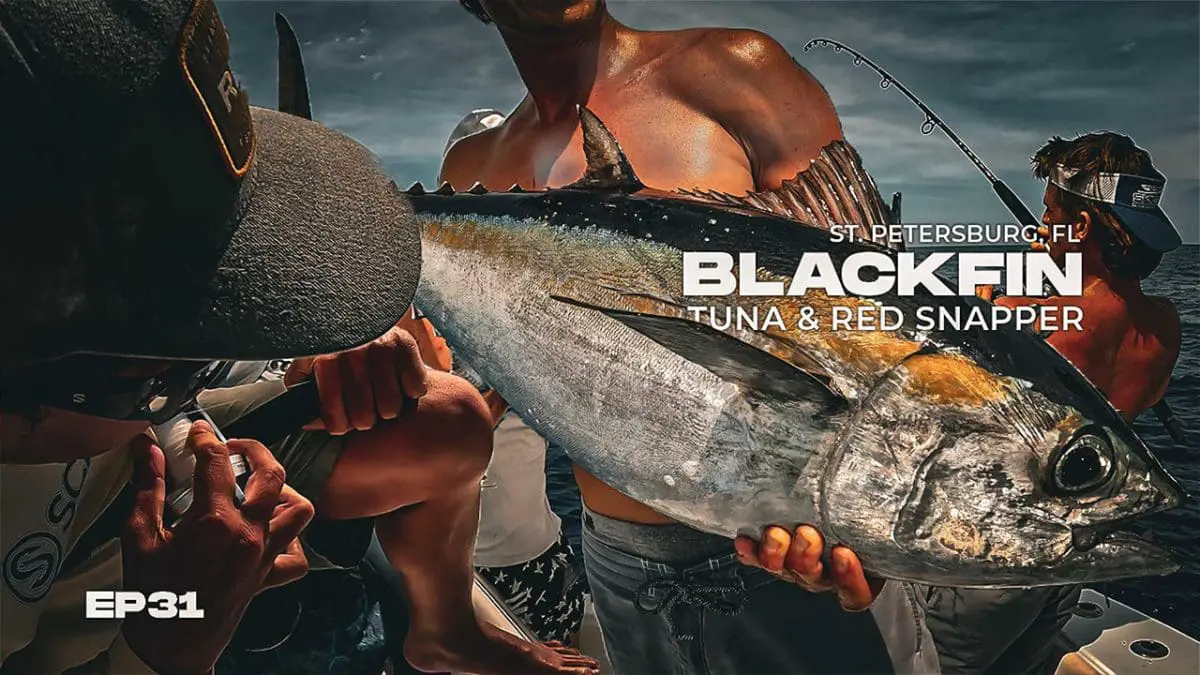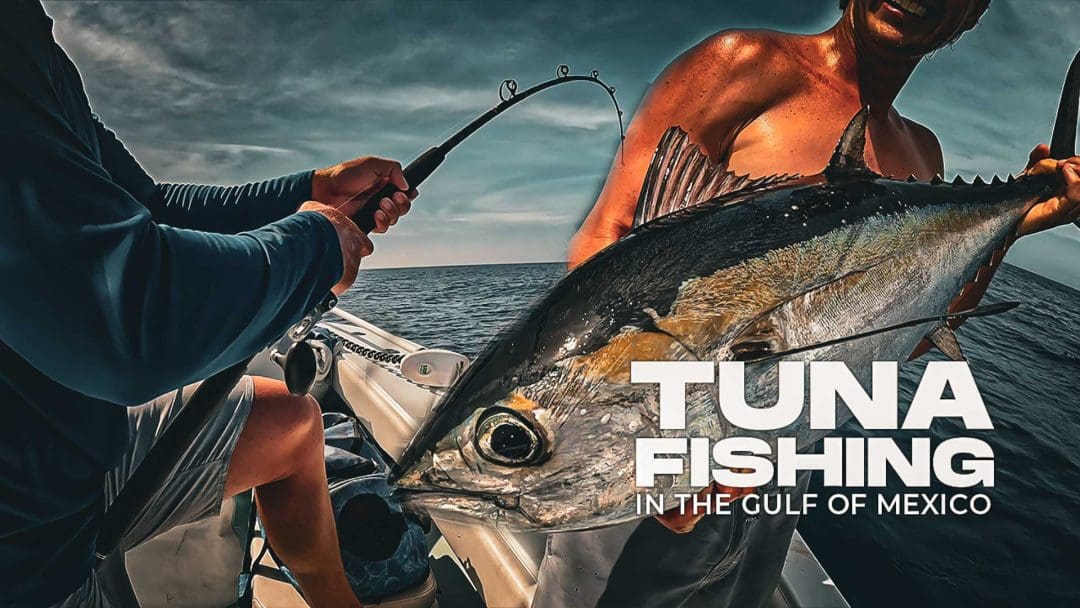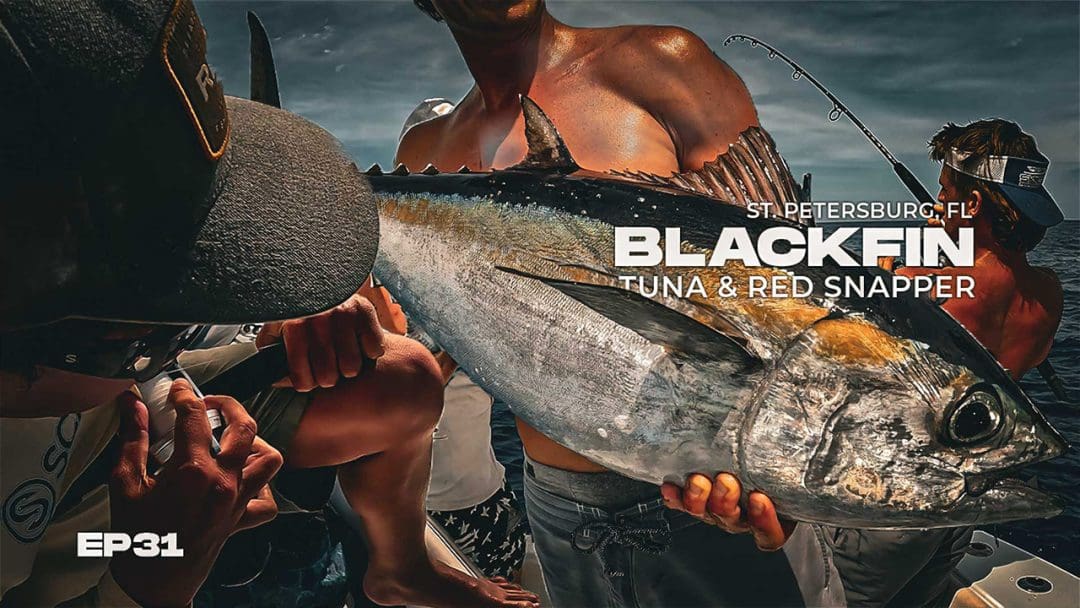Blackfin Tuna Fishing
Blackfin tuna are fast and strong game fish commonly found in warm waters. They can be caught in the Atlantic Ocean, Gulf of Mexico, and Caribbean Sea.
Watch Video: Gulf of Mexico Blackfin Tuna & Red Snapper
Caution: This video about catching blackfin tuna is an unpredictable, excitement-packed adventure. Brace yourself for thrilling moments and unexpected outcomes. Our language might get spirited, but it’s all in good fun as we celebrate the chase. Landed continues to improve video content and language is an important concern of ours. Viewer discretion advised for those allergic to unabashed enthusiasm and who prefer a more sedate fishing experience.
About Blackfin Tuna
The Blackfin Tuna, the smallest in the tuna family, is a prized catch in warmer offshore waters. It’s identifiable by its dark blue back, silvery belly, and yellow stripe. This fast and agile species, weighing between 5 to 30 pounds, is found around reefs, wrecks, and deep-sea areas, appealing to deep sea fishing enthusiasts for both its challenge and taste.
To catch Blackfin Tuna, anglers commonly use trolling with feathered jigs or cedar plugs and live bait fishing with pilchards, sardines, or herring. These techniques, effective around offshore structures, require adapting to the fish’s behavior and environmental conditions. Known for their spirited fight, Blackfin Tuna are a favorite among sport fishermen.
How to Catch Blackfin Tuna
Choosing the best location for catching Blackfin Tuna involves considering several key factors. Tuna are typically found in warmer waters, so tracking sea surface temperatures can be beneficial. Look for areas where warm and cool waters converge, as these are likely to be rich in baitfish, attracting tuna.
Current Water Surface Temperatures in the Gulf of Mexico
Anglers today have access to some really big advantages. The internet can provide a wealth of information about water currents and sea surface temperature.
Focusing on underwater structures like oil rigs, reefs, and drop-offs is important, as Blackfin Tuna often congregate around these areas to feed. Using sonar technology can help identify these structures and the presence of fish. Also the time of year can be important since Blackfin Tuna migration and feeding habits change seasonally.
Before heading out check a few local fishing reports and knowledge from experienced anglers can provide insights into recent catches as well as successful fishing spots. Combining these strategies increases the chances of catching Blackfin Tuna in the Gulf of Mexico.
Fishing Gear for Blackfin Tuna
Important information about fishing gear to improve your chances of catching blackfin tuna in the Gulf:
Fishing Rod and Reel for Tuna:
Medium-heavy to heavy spinning rod or a conventional rod with a fast action. Pair it with a high-quality reel capable of handling the fight.
Fishing Line for Tuna:
Depending on the size of tuna, spool your reel with a strong and abrasion-resistant fishing line, typically in the 20 to 60 pound test range.
Best Times to Catch Blackfin Tuna
Time to Catch Blackfin Tuna
In the Gulf, generally the peak season for Blackfin Tuna spans from late spring to early fall.
During this period, the warm waters attract large schools of Blackfin Tuna, making it an ideal time to catch them.
Where to Catch Blackfin Tuna
Blackfin Tuna can be found in various locations off the coast of Florida.
One particularly fruitful area is the Gulf Stream, which runs along the eastern coast of the state.
Best Fishing Techniques to Catch Blackfin Tuna
Various fishing techniques such as trolling with cedar or Yo-Zuri plugs, islanders, softheads, and ballyhoo can help catch Blackfin Tuna, the most successful approach in the Gulf of Mexico involves chumming, chunking, and live baiting.
Among these techniques, chumming with fresh bonito proves to be highly effective, although frozen bonito, Boston mackerel, king mackerel or other available bait fish can also serve as suitable alternatives.
Best Bait and Lures for Catching Blackfin Tuna
Blackfin tuna, a prized catch for many anglers, respond well to a variety of baits, both live and artificial.
Live Bait for Blackfin Tuna Fishing:
For live bait, small fish such as pilchards, sardines, and herring are particularly effective.
These baits mimic the natural prey of blackfin tuna, making them irresistible when trolled or drifted in areas where these tunas feed.
Pilchards, herring, or small bonito make excellent live baits for blackfin tuna.
Artificial Lures:
Artificial baits for Tuna include, feathered jigs, cedar plugs, and small to medium-sized lures in colors that mimic baitfish, like blue, silver, and green, have proven successful.
The key with artificial baits is to mimic the movement and appearance of the tuna’s natural prey, often achieved through specific retrieval techniques that create a lifelike action in the water.
Feathers, jigs, or diving plugs in silver, blue, or pink colors are effective choices. Trolling with rigged baits or lures is a popular method.
Whether using live or artificial baits, the key to success lies in understanding the feeding habits of the blackfin tuna and adapting your technique to the conditions of the day.
Fishing Techniques for Blackfin Tuna
Trolling for blackfin tuna:
Tuna are some of the faster swimmers in the Gulf. Maintain a speed of around 6 to 8 knots while trolling is well within tuna’s ability, however, varying speed up or down, may be necessary to entice a strike.
Spreading Out:
Use outriggers or downriggers to spread out your lines and fish the water column by presenting multiple baits at different depths.
Target Areas for tuna
Look for visible surface and/or “diving” bird activity, floating debris, weed lines, or temperature breaks, as blackfin tuna often gather around these features.
“Chunking” for tuna
Chunking involves creating a slick of small baitfish chunks in the water to attract Blackfin Tuna. Start by securing fresh baitfish, such as pilchards or sardines, and cut them into small pieces.
Chum Slick for Tuna:
Create a chum slick by using a mix of chopped baitfish, fish oil, and scent-enhancing substances.
Disperse these chunks behind your boat while periodically dropping larger chunks attached to hooks. This technique often proves highly effective in enticing Blackfin Tuna to surface and feed.
Jigs for Blackfin Tuna:
Vertical jigging can also be used for catching blackfin tuna:
Use heavy jigs in the 2 to 6-ounce range with a fast retrieve.
Drop the jig to the desired depth and rapidly lift and drop the rod tip to create an enticing action.
The Gulfstreams’ warm current creates an ideal habitat for Blackfin Tuna and serves as a major migratory route for their feeding patterns.
Additionally, key fishing spots for Blackfin Tuna in Florida include popular areas like Tampa, Islamorada, Key West, as well as Fort Lauderdale.
Blackfin Tuna Fishing Tips:
Handling the fight of tuna and landing process.
Trying to outpower big, powerful fish such as tuna can be a dangerous strategy. Instead, once hooked up let the tuna run, only when the blackfin tuna slows down, begin working the fish by leveraging up with the tip of the rod and reeling as you lower the rod tip.
Landing Blackfin Tuna:
Be prepared for a spirited fight as blackfin tuna are known for their acrobatic leaps and strong runs.
Maintain steady pressure on the line while allowing the fish to run.
When you have hooked a Blackfin Tuna or any large gamefish, it’s crucial to maintain a steady and consistent pressure on the line.
Avoid jerking or reeling excessively hard, as this can lead to the line breaking or the hook pulling out.
Instead, apply steady pressure by using the rod’s strength and your body positioning.
Keep the line tight and apply pressure when the fish is running, and then ease up slightly when it changes direction or slows down.
This technique helps tire out the fish gradually without causing unnecessary strain on the tackle.
Utilize the Rod and Reel’s Drag System:
The drag system on your reel is a vital tool when fighting larger gamefish.
Set your drag correctly based on the line strength and the fish’s size, allowing it to release line under pressure to prevent a sudden break.
The drag should be tight enough to tire out the fish but still have some give when the fish makes powerful runs.
Adjust the drag smoothly during the fight if needed, depending on the fish’s behavior and your angling situation.
A well-adjusted drag system can help you avoid line breaks and maintain control over the fight.
Proper Body Mechanics when Fighting Blackfin Tuna
Keep your stance wide and balanced, distributing your weight evenly. This provides stability and prevents you from being easily pulled off balance by the fish’s powerful runs.
Use your legs, core, and shoulders to generate force while reeling, rather than relying solely on your arms. Engaging these larger muscle groups reduces fatigue and allows you to exert more power during the fight.
Try to maintain good posture and avoid leaning back excessively, as it can compromise your control over the rod and reel.
Blackfin Tuna Size Limits in the Gulf
| Fishing Area | Minimum Size Limit (Inches) |
|---|---|
| Federal Waters | 20 |
| Alabama State | 16 |
| Florida State | 20 |
| Louisiana State | 14 |
| Mississippi State | 14 |
| Texas State | 16 |
Once the tuna is exhausted, use a gaff or a landing net to bring it aboard.
Familiarize yourself with local fishing regulations and size limits for blackfin tuna in your area. Always practice responsible fishing to ensure the sustainability of this species for future generations.
Explore More

Tampa Florida Kingfish Nearshore + Offshore Fishing Kingfish, also known as king mackerel, are a prized catch in the…
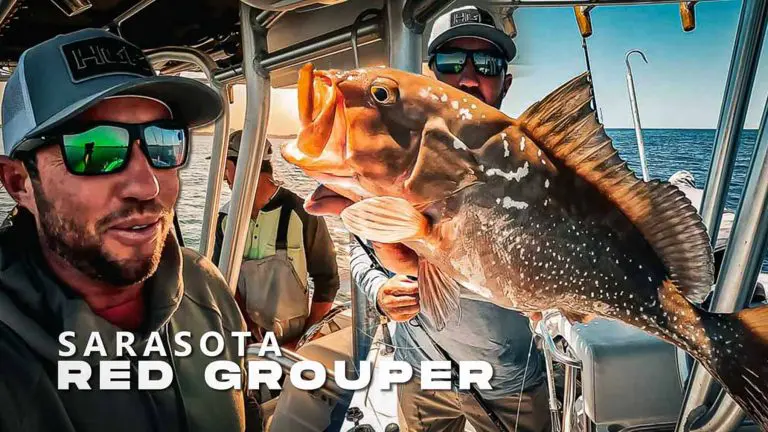
Techniques for Red Grouper: Sarasota Offshore Fishing As dawn breaks over Sarasota, Florida, Captain Shaw and Junior from the…
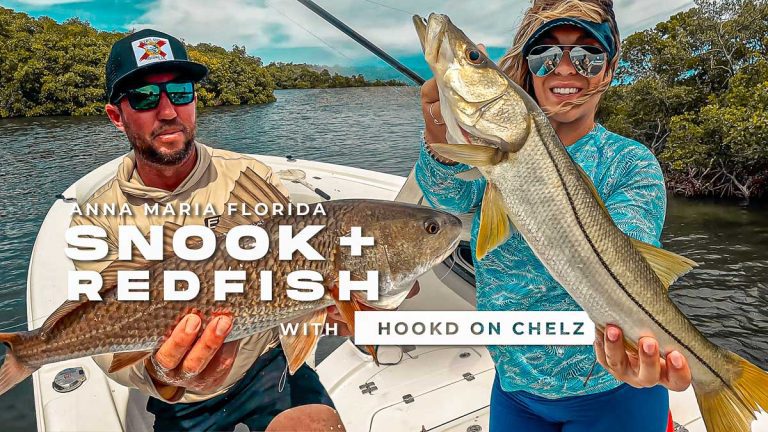
Anna Maria Island Redfish + Snook Anna Maria Island, nestled on Florida’s Gulf Coast, is not only a fishing…

